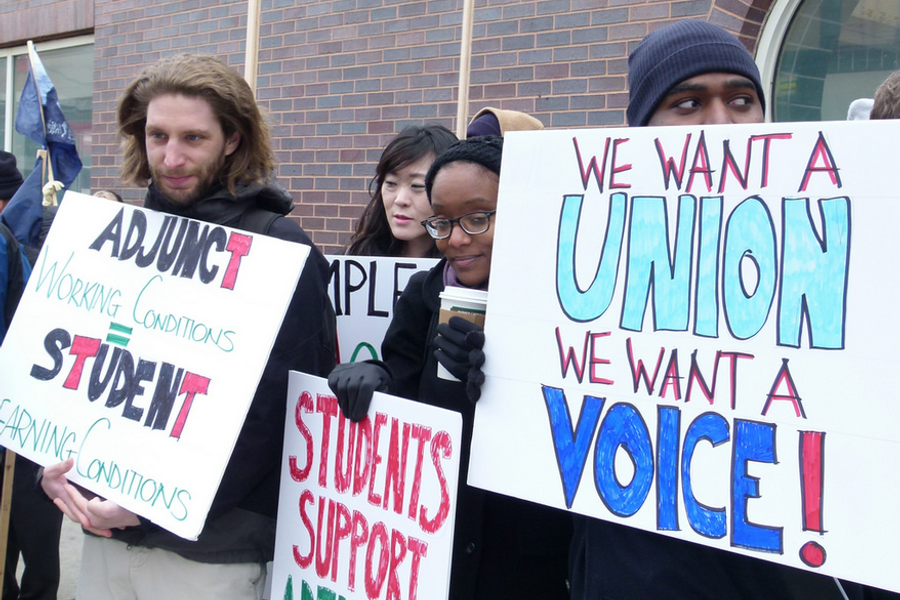At 100 Colleges Around the Country, Adjuncts Take Action to Demand an End to Precarity and Low Pay
Andrew Mortazavi

Yesterday, adjunct faculty members at over 100 college campuses carried out coordinated demonstrations as part of National Adjunct Walkout Day. Adjuncts aimed to draw attention to low pay, exploitative working conditions, and a lack of job security. They organized walkouts, “teach-ins,” and rallies to push for part-time academic workers’ rights and greater visibility.
While specific goals varied among activists, most adjuncts organizing around the event are demanded better pay, more job security, and access to benefits.
“Our two main priorities are pay equity and the job security of multi-year contracts,” said Joel Smith, an adjunct and organizer in the University of Arizona English department. University of Arizona adjuncts participated in the walkout by taking their students to an on-campus plaza for a demonstration and discussions about adjuncts in higher education.
Adjuncts, also referred to as part-time or contingent faculty even though they often teach full-time course loads and regularly have their contracts renewed to teach the same classes year after year, have become the underclass of higher education. They typically lack basic benefits and employment security and are paid a small fraction of what their full-time colleagues make, both annually and per course.
While the word adjunct literally means “a supplementary rather than essential part,” adjunct faculty are an integral part of the new corporate model of higher education that has come to dominate academia in recent decades. As colleges have increasingly cut back on tenure-track appointments since the 1970s, adjuncts, as well as graduate student teachers who also typically work for low pay, have picked up the slack.
According to the American Association of University Professors (AAUP), 76 percent of college instructors in the United States are no longer in tenure-track positions. Forty-one percent of faculty, according to the AAUP, are adjuncts.
As the ranks of adjuncts have swelled and pay has failed at many colleges to even keep up with inflation, adjuncts have been organizing for years, pushing for better working conditions and representation. They are unionizing in increasing numbers, as well as engaging in grassroots organizing to raise awareness of the issues adjuncts face.
The media and public have taken note. When an 83-year-old longtime adjunct, who was not renewed for her adjunct position at Duquesne University, died on the streets after bouts of cancer and quasi-homelessness in late 2013, adjuncts and their supporters pointed to her as a symbol for systemic exploitation. Stories of adjunct exploitation became commonplace in the news, and social media became an incubator for online activism, with hashtags like #NotYourAdjunctSidekick used to keep the discussion public.
National Adjunct Walkout Day arose from that online activism. The event was initially proposed by an anonymous adjunct in the writing program at San Jose State University. In an interview, the initiator, credited only as “aka National Adjunct,” said that adjuncts at SJSU were not even earning minimum wage once they calculated all the hour spent working in and out of the classroom.
According to the Chronicle of Higher Education’s Adjunct Project, adjuncts report a median of $2,987 per three-credit course nationally, though the AAUP puts the average figure closer to $2,700. (In my own adjunct days, I was paid as low as $1,550 for a three-credit-hour course.) Because adjuncts can spend several hours working outside the classroom for every hour they spend teaching, this often breaks out to around, or even below, the national minimum wage.
Meanwhile, the average salary for full professors at public doctoral institutions was $126,981 in the 2013-2014 school year. According to the Institute for Policy Studies, average executive compensation at public research universities nationwide in 2012 was $544,554 and rising. The growth in administrative spending has far outstripped growth in money spent on instruction year after year. At the University of Arizona, some adjuncts say only 24 percent of revenue is spent on instruction.
“This is going on on every single campus in America,” the anonymous NAWD initiator said. “And why hasn’t something national been done about this?”
While there has been no coordinated national action, at least until now, union groups have worked to coordinate adjunct organization on a broader scale. Over the last decade, SEIU has helped unionize 22,000 adjuncts across the country through their Adjunct Action program that employs a “metro strategy,” targeting multiples campuses in an area simultaneously.
By some reports, as many as 25 percent of adjuncts nationwide may now enjoy some form of union representation. Adjuncts at unionized schools often report higher pay, such as Tufts, which pays adjuncts at least $6,000 per course, well above the national average. According to NYU Local, unionized adjuncts at NYU made at least $5,000 per course in 2013, whereas nonunionized adjuncts on the same campus were often paid as little as $2,500 a class.
However, not all states allow public workers to unionize and right-to-work laws can kill adjunct unions before they get off the ground. Smith noted that at the University of Arizona, the path to unionization was not clear because of state right-to-work laws.
Unionization is also no panacea. Adjuncts at San Jose State University, as the anonymous initiator of NAWD notes, are represented by a union that has helped adjunct faculty members gain access to health benefits and multiyear contracts, perks few adjuncts enjoy. And adjuncts at Chicago’s Columbia College recently voted to disaffiliate from their national union, the National Education Association Association, because they felt their representation was lackluster. Nonetheless, stagnating wages and rising inflation have resulted in a situation in which adjunct faculty members still struggle to make ends meet, according to the NAWD initiator.
While yesterday’s demonstrations were referred to as “walkouts,” adjuncts, or at least the vast majority of them, did not abandon their students in the classroom. Instead, many held “teach-ins” and invited students to attend the demonstrations in order to educate them about adjunct exploitation.
Mick Parsons, part-time lecturer at the University of Louisville and one of the organizers of the Louisville Teach-in, a joint movement between adjunct faculty at the University of Louisville and Jefferson Community and Technical College, said that just walking out of the classroom would be a missed opportunity to educate students about why the current system of higher education is such a problem.
“We would prefer that everyone was onboard with the issues. Just walking out would not educate people about the reason for [the demonstrations],” Parsons says.
University of Louisville administrators did not respond to requests for comment.
According to Parsons, the same university system that exploits adjuncts is detrimental to student success. The precarious conditions under which adjuncts toil can affect even the best instructors’ ability to perform their jobs, according to Kathryn Lafferty, another Louisville Teach-in organizer.
The Louisville Teach-in, like other demonstrating adjunct groups, aimed not just to make their case to students, but the larger public and lawmakers, as well. In Louisville, adjuncts publicized the event in their communities and to members of the press. They also extended invitations to college administrators and local policymakers to attend the outdoor rally.
Smith reported also inviting administrators to the University of Arizona demonstration in an effort to foster a collaborative spirit. At the rally, demonstrators presented an open letter to UA President Ann Weaver Hart aloud. Though invited to the walkout, she did not attend.
Smith did note collaboration with the administration, though, and positive communications between adjunct organizers and administrators in the days leading up to the event. “We’re hoping to work with administration and raise awareness about the plight of the adjunct,” Smith said.
Tom Miller, Vice Provost of Faculty Affairs at the University of Arizona, reaffirmed the spirit of collaboration, saying that the adjunct situation “is not experienced here as a conflict between administration and faculty. I think it is experienced here as a challenge facing all faculty.”
Though tenure-track positions at the University of Arizona are in decline, the administration has been working to reduce reliance on part-time faculty by consolidating part-time positions into full-time, benefits-eligible positions off the tenure track. The administration is also working with the faculty senate to examine the use of multi-year contracts as a way to support non-tenure-track faculty.
“We have reduced the number of part time adjuncts, … recognizing that this is not an effective way to support our students, and moving people into fulltime positions,” Miller says. “This is in direct opposition to the national trend.”
But adjuncts at other universities reported some fear of retaliation and apprehension over participating in the walkouts, which may be the real reason National Adjunct Walkout Day quickly became National Adjunct Teach-in Day. Retaliation would be easy to execute and difficult to prove. Without tenure or multi-year contracts, most adjuncts have no job security. Dismissing an adjunct from employment is as simple as not assigning them courses for the next semester. In some states, public workers are explicitly barred from walking out and could face fines, though there has been no evidence of this actually happening to adjuncts.
John Martin, chair of the California Part-time Faculty Association and an organizer of a teach-in at Butte College says, “I have not heard of any actual quote-unquote walkout.” Nor did anyone else contacted for this article, including the NAWD initiator. Martin noted that, “You can’t ask teachers who are dependent on their low wages to walk out.”
While the precarious nature of adjunct work might have kept some from participating, with adjuncts from over a 100 colleges represented in North America, Europe, and Australia, clearly many were not deterred from engaging in some organizing.
“The fact of the matter is we only have one-year contracts,” Smith says. “Adjuncts are always feeling precarious and apprehensive at this time of the year because their contract is about to end anyway. The precarious nature of this work is why we are having this event.”






